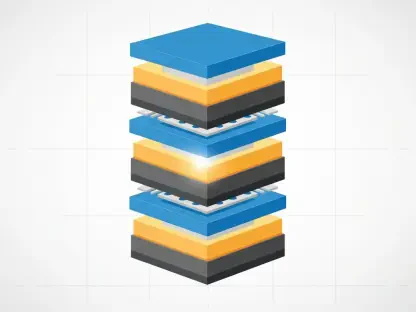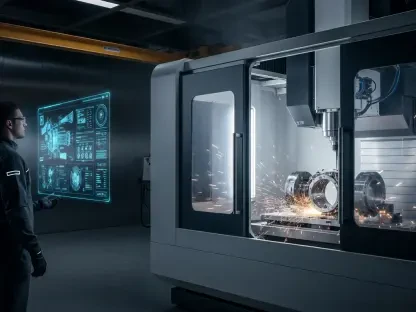Imagine a world where artificial intelligence powers every facet of technology, from the data centers driving global cloud services to the personal devices in your hands, yet the industry struggles to keep pace with skyrocketing demand. This is the reality facing the semiconductor sector today, as the hunger for AI infrastructure pushes companies to forge unprecedented alliances. One such collaboration, a $5 billion partnership between Nvidia, the titan of AI and graphics processing units (GPUs), and Intel, a legacy semiconductor giant grappling with recent setbacks, stands out as a potential turning point. This review dives into the intricacies of their joint venture, exploring how it aims to redefine computing and AI innovation amid intense global competition.
Strategic Foundations of the Alliance
The partnership between Nvidia and Intel marks a significant pivot for both companies in a rapidly shifting tech landscape. Nvidia, currently the world’s most valuable company due to its dominance in AI technology, has joined forces with Intel, a firm that once led the semiconductor industry but has faltered in recent years with financial losses nearing $19 billion. This alliance, valued at a staggering $5 billion, emerges as a strategic lifeline for Intel while offering Nvidia an opportunity to expand its ecosystem through Intel’s established infrastructure.
At the heart of this collaboration lies a mutual recognition of complementary strengths. Nvidia brings its cutting-edge AI expertise and GPU prowess to the table, while Intel offers decades of experience in semiconductor design and its widely adopted x86 architecture. The deal also aligns with broader national interests, as evidenced by the U.S. government’s recent acquisition of a 10% stake in Intel to bolster domestic tech capabilities, highlighting the geopolitical stakes at play in this union.
Technological Innovations and Core Objectives
Custom Data Center Chips for AI Dominance
A primary focus of this partnership is the development of custom data center chips tailored for AI infrastructure. By merging Nvidia’s advanced AI algorithms and GPU technology with Intel’s chip design expertise, the collaboration aims to create solutions that can handle the immense computational demands of modern AI workloads. This synergy promises to deliver chips with superior performance, potentially outpacing existing offerings in efficiency and scalability.
The significance of this endeavor cannot be overstated, given the explosive growth of AI applications across industries. From cloud computing giants to autonomous vehicle manufacturers, the need for robust AI infrastructure is universal, and these custom chips could position Nvidia and Intel as leaders in meeting that demand. Such innovation might also reduce dependency on foreign manufacturing, aligning with national efforts to strengthen local production capabilities.
Revolutionizing Personal Computing with AI
Beyond data centers, the alliance targets personal computing by integrating Nvidia’s innovative tech with Intel’s entrenched x86 ecosystem. The goal is to craft PC products that offer enhanced AI capabilities, such as real-time processing for gaming, content creation, and productivity tools. This could translate into laptops and desktops that are not only faster but also smarter, adapting to user needs through machine learning.
This focus on AI-enhanced personal devices taps into a growing consumer expectation for seamless, intelligent technology. Imagine a laptop that optimizes battery life based on usage patterns or a gaming rig that dynamically adjusts graphics settings for peak performance. If successful, these products could redefine user experiences and set a new standard in the competitive PC market.
Industry Dynamics and Competitive Edge
The semiconductor and AI industries are at a crossroads, with AI emerging as the cornerstone of technological progress. Global competition is fiercer than ever, as nations and corporations vie for supremacy in chip production and innovation. This partnership arrives at a critical juncture, countering moves by competitors like China, which has restricted purchases of Nvidia chips and expanded its own AI hardware through companies like Huawei.
Strategically, the Nvidia-Intel alliance dovetails with U.S. initiatives to maintain technological leadership. By pooling resources, the duo aims to accelerate innovation cycles and fortify domestic supply chains, a priority amid ongoing geopolitical tensions. This collaboration could serve as a blueprint for how legacy firms and modern giants can unite to address industry-wide challenges.
Moreover, the partnership underscores a shift toward collaborative ecosystems over isolated competition. As AI workloads grow more complex, no single company can dominate alone, making such alliances not just beneficial but necessary for sustained progress in the sector.
Market Reactions and Practical Applications
The announcement of this partnership sent shockwaves through financial markets, with Intel’s stock soaring by 25% in a single day, marking its most significant gain in decades. Nvidia’s shares also saw a positive uptick of 2%, reflecting investor confidence in the strategic merits of the deal. Analysts have hailed this as a potential turning point for Intel, positioning it to reclaim relevance in the AI era.
In practical terms, the innovations from this collaboration could transform multiple sectors. Cloud computing providers might leverage custom AI chips to enhance server efficiency, while gaming companies could integrate advanced GPUs into next-generation consoles for unparalleled realism. Enterprise solutions, too, stand to benefit, with AI-driven analytics becoming more accessible through optimized hardware.
The ripple effects extend to smaller industries as well, such as healthcare, where AI-powered devices could streamline diagnostics, or education, where personalized learning tools might become more powerful. These applications illustrate the broad potential of the partnership to impact everyday life through technology.
Obstacles on the Horizon
Despite the optimism, significant challenges loom over this alliance. A key uncertainty is the absence of a finalized manufacturing agreement, leaving questions about where and how these chips will be produced. This gap could place the partnership at a disadvantage compared to competitors like Taiwan Semiconductor Manufacturing Company (TSMC), which currently fabricates Nvidia’s flagship processors.
Regulatory hurdles and geopolitical factors add further complexity. With global supply chains under scrutiny, securing approvals for such a high-stakes deal may prove arduous. Additionally, Intel’s ongoing financial recovery, including plans for substantial workforce reductions, raises concerns about its capacity to execute on ambitious joint projects.
Internal dynamics between the two companies also warrant attention. Aligning corporate cultures and technical priorities could introduce friction, especially given their historically competitive stances. Navigating these issues will be crucial to realizing the partnership’s full potential.
Long-Term Vision and Potential Breakthroughs
Looking ahead, the Nvidia-Intel collaboration holds promise for groundbreaking advancements in AI and computing technology. Over the next few years, from 2025 onward, this alliance could yield chips that redefine performance benchmarks, potentially reshaping data center architectures worldwide. Such innovations might also spur new categories of consumer devices, blending AI with everyday computing in ways previously unimagined.
The partnership’s influence on the semiconductor landscape could be profound, strengthening U.S. competitiveness against international rivals. By fostering a robust domestic tech ecosystem, it may help mitigate risks associated with global supply chain disruptions, ensuring a more resilient industry framework.
Furthermore, success here could inspire similar collaborations across the tech sector, encouraging a model of shared innovation. This long-term vision positions the alliance as not just a business deal, but a catalyst for systemic change in how technology evolves.
Final Reflections
Reflecting on this monumental partnership, it becomes clear that the alliance between Nvidia and Intel represents a bold step toward addressing the semiconductor industry’s most pressing challenges. Their combined expertise in AI and chip design offers a glimpse into a future where technology adapts more intuitively to human needs. The market’s enthusiastic response underscores the high expectations placed on their joint efforts.
As a next step, stakeholders need to prioritize securing a manufacturing framework to anchor their ambitious plans. Overcoming regulatory and geopolitical barriers also emerges as a critical focus to ensure smooth progress. Ultimately, sustained commitment to innovation and collaboration paves the way for this partnership to leave an indelible mark on the tech world, guiding the industry toward a more integrated and competitive era.









